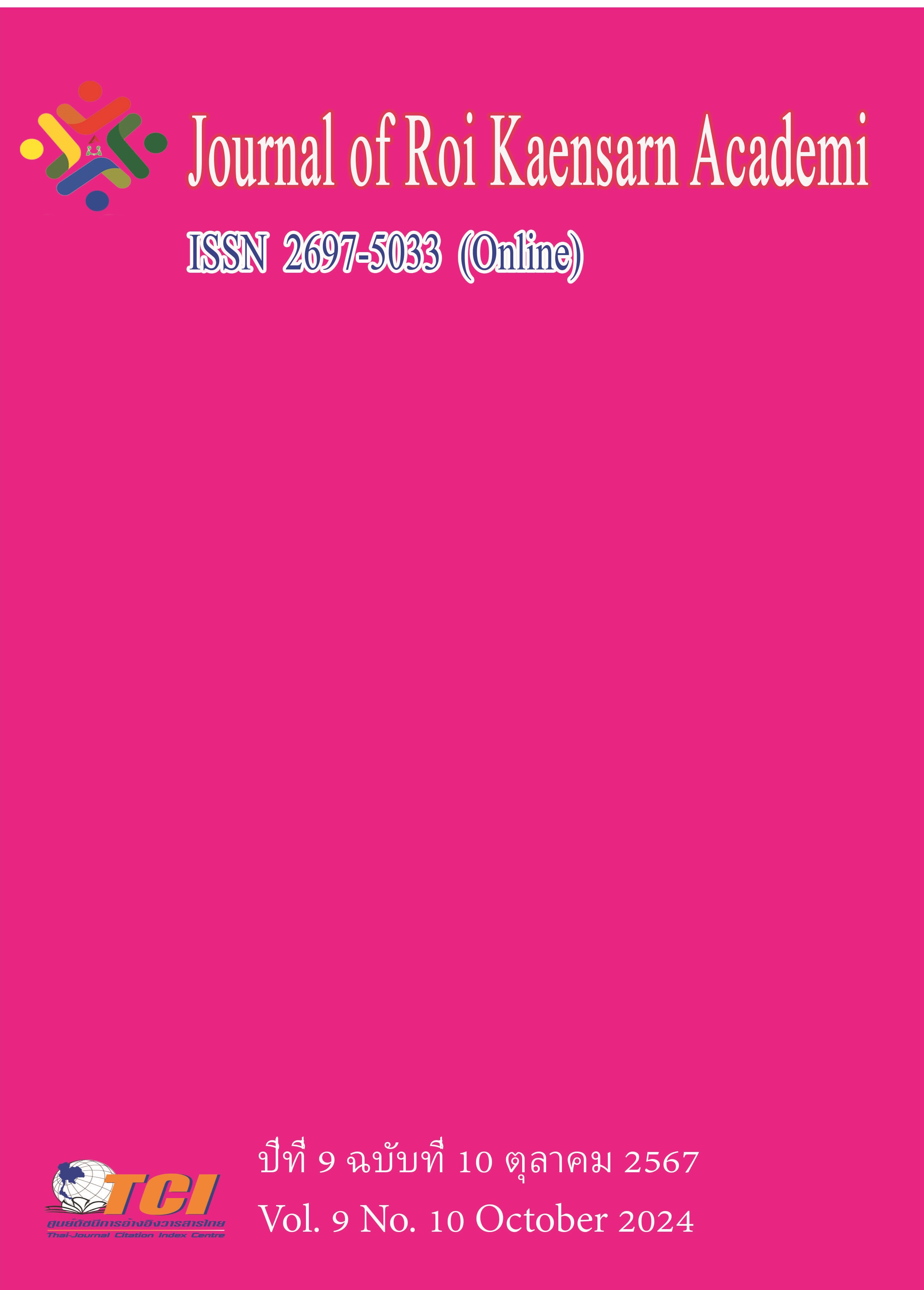แบบจำลองความสัมพันธ์เชิงโครงสร้างที่มีอิทธิพลต่อผลการดำเนินงานของธุรกิจ ในอุตสาหกรรมของประเทศไทย
Main Article Content
บทคัดย่อ
ปัจจุบันการดำเนินธุรกิจของอุตสาหกรรมในประเทศไทยต้องประสบกับปัจจัยหลากหลายที่ส่งผลกระทบกับการดำเนินงานของธุรกิจจากภาวะเศรษฐกิจที่ผันผวน การศึกษานี้เป็นการบูรณาการแนวคิดทฤษฎีโดยมีวัตถุประสงค์เพื่อศึกษา (1) องค์ประกอบการมุ่งเน้นตลาด การมุ่งเน้นการเรียนรู้ คุณภาพบริการ และผลการดำเนินงานของธุรกิจ (2) ยืนยันความสัมพันธ์เชิงโครงสร้างที่มีอิทธิพลต่อผลการดำเนินงานของธุรกิจ และ (3) ตรวจสอบความสัมพันธ์เชิงสาเหตุของผลการดำเนินงานของธุรกิจในอุตสาหกรรมของประเทศไทย ที่มีการตรวจสอบความสอดคล้องของตัวแบบจำลองและข้อมูลเชิงประจักษ์ ผู้วิจัยใช้เทคนิคการวิจัยเชิงสำรวจ โดยเก็บรวบรวมข้อมูลกลุ่มตัวอย่างเจ้าของธุรกิจหรือบุคคลที่ได้รับมอบหมายจำนวน 320 ตัวอย่าง จากจำนวนประชากร 921 บริษัท สถิติเชิงพรรณนาที่ใช้ในการวิเคราะห์ ได้แก่ ค่าร้อยละ ค่าเฉลี่ย ส่วนเบี่ยงเบนมาตรฐาน ค่าสัมประสิทธิ์ความแปรปรวน ค่าความเบ้ และค่าความโด่ง สถิติเชิงอนุมานที่ใช้ในการวิเคราะห์ ได้แก่ ค่าสัมประสิทธิ์สหสัมพันธ์แบบเพียร์สัน และตัวแบบจำลองสมการโครงสร้าง (Structural Equation Modeling: SEM) โดยใช้โปรแกรม AMOS (Analysis Moment of Structure)
ผลการศึกษาพบว่า (1) ผู้บริหารส่วนใหญ่แสดงความคิดเห็นต่อทุกองค์ประกอบอยู่ในระดับมากที่สุด (2) ทุกองค์ประกอบมีความสัมพันธ์กันอย่างมีนัยสำคัญทางสถิติที่ระดับ 0.01 และ (3) ผลการวิเคราะห์ตัวแบบสมการโครงสร้างพบว่า การมุ่งเน้นตลาดมีอิทธิพลต่อการมุ่งเน้นการเรียนรู้ (TE=0.81) การมุ่งเน้นตลาดมีอิทธิพลต่อคุณภาพบริการ (TE=0.86) การมุ่งเน้นตลาดมีอิทธิพลต่อผลการดำเนินงานของธุรกิจ (TE=0.89) การมุ่งเน้นการเรียนรู้มีอิทธิพลต่อคุณภาพบริการ (TE=0.34) การมุ่งเน้นการเรียนรู้มีอิทธิพลต่อผลการดำเนินงานของธุรกิจ (TE=0.46) และคุณภาพบริการมีอิทธิพลต่อผลการดำเนินงานของธุรกิจ (TE=0.33) สอดคล้องกับข้อสมมติฐานอย่างมีนัยสำคัญทางสถิติที่ระดับ 0.01 และ 0.001
Article Details
References
ตลาดหลักทรัพย์แห่งประเทศไทย. (2566). รายชื่อบริษัทจดทะเบียนในตลาดหลักทรัพย์. ออนไลน์. สืบค้นเมื่อ 10 มีนาคม 2567. แหล่งที่มา: https://www.set.or.th/dat/eod/listedcompany/static/ listedCompanies_th_TH.xls
ยุทธ ไกยวรรณ์. (2556). การวิเคราะห์โมเดลสมการโครงสร้างด้วย AMOS. กรุงเทพมหานคร: สำนักพิมพ์แห่งจุฬาลงกรณ์มหาวิทยาลัย.
สำนักงานเศรษฐกิจอุตสาหกรรม กระทรวงอุตสาหกรรม. (2567). รายงานภาวะเศรษฐกิจอุตสาหกรรม ปี 2566 และแนวโน้มปี 2567. ออนไลน์. สืบค้นเมื่อ 10 มีนาคม 2567. แหล่งที่มา: https://km.fti. or.th/wp-content/uploads/2024/01/รายงานภาวะเศรษฐกิจอุตสาหกรรม.pdf
Abd-Elrahman, Hassanien A., El-Borsaly, A. and Hassan, Sally A. M. (2020). The impact of service quality on organizational performance in the mobile telecommunications sector in Egypt. Proceedings on Engineering Sciences. 2 (1), 93-104.
Aden, Abdulkadir A. and Gichinga, L. (2016). Effects of customer care on organizational performance of telecommunication companies in Mogadisho-Somalia. Journal of Business Management. 2 (9), 74-88.
Hair, Joseph F., Black, William C., Barry, Babin J. and Rolph, Anderson E. (2010). Multivariate data analysis. (7th ed.). New Jersey: Pearson Prentice Hall.
Hurley, Robert F. and Hult, Tomas M. G. (1998). Innovation, market orientation, and organizational learning: an integration and empirical examination. Journal of Marketing. 62 (3), 42-54.
Jawad, Sakhawat, U. R. S., Naushad, S., Yousaf, S. and Yousaf, Z. (2020). Exploring performance of software houses: market orientation and mediating role of firm innovativeness. World Journal of Entrepreneurship, Management and Sustainable Development. 16 (1), 1-11.
Kaplan, Robert S. and Norton, David P. (1996). Linking the balanced scorecard to strategy. California Management Review. 39 (1), 53-79.
Leischnig, A., Henneberg, Stephan C. and Thornton, Sabrina C. (2016). Net versus combinatory effects of firm and industry antecedents of sales growth. Journal of Business Research, Elsevier. 69 (9), 3576-3583.
Mulyana, M., Sutapa, S. and Wasitowati, W. (2020). Product innovation agility on business performance: The role of market and learning orientation. Contaduría y administración. 65 (4), 1-23.
Narver, John C. and Slater, Stanley F. (1990). The effect of a market orientation on business profitability. Journal of Marketing. 54 (4), 20-35.
Novixoxo, Jewel D., Pomegbe, Wisdom W. K. and Dogbe, Courage S. K. (2018). Market orientation, service quality, and customer satisfaction in the public utility companies. European Journal of Business and Management. 10 (30), 37-46.
Parasuraman, Parsu A., Zeithaml, Valarie A. and Berry, Leonard L. (1988). SERVQUAL a multiple-item scale for measuring consumer perceptions of service quality. Journal of Retailing. 64 (1), 12-40.
Phasuk, Watcharapun. (2014). Market orientation and learning orientation in developing innovation capabilities and business performance of medium-sized industrial. Journal of Public and Private Sector Management. 21 (2), 102-126.
Phorncharoen, Irada. (2020). Influence of market orientation, learning orientation, and innovativeness on operational performance of real estate business. International Journal Engineering Business Management. 12 (5), 1-11.
Rostini, R., Souisa, W., Masmarulan, R. and Yasin, Nurfatwa A. (2021). Competitiveness development, learning orientation, entrepreneurial commitment and business performance in the silk industry. Management Science Letters. 11, 903-908.
Sinkula, James M., Baker, William E. and Noordewier, Thomas G. (1997). A framework for market-based organizational learning: linking values, knowledge, and behavior. Journal of the Academy of Marketing Science. 25 (4), 305-318.
Yuan, Y., Feng, B., Lai, F. and Collins, Brian J. (2018). The role of trust, commitment, and learning orientation on logistic service effectiveness. Journal of Business Research. 93, 37-50.
Yudhyani, Ujianto E. and Retnaningsih, W. (2020). Service quality mediation effect of entrepreneurial orientation, and learning orientation on the performance of Stars Hotel in east Kalimantan. Archives of Business Research. 8 (4), 105-115.
